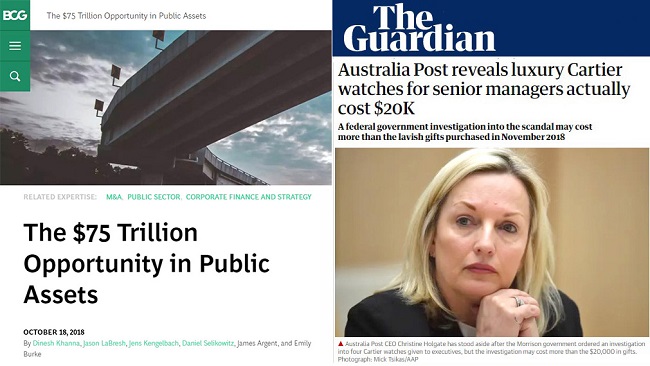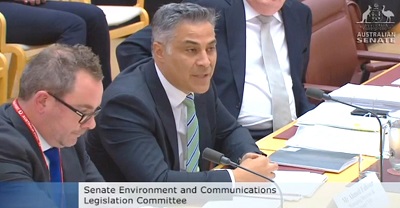When Labor Senator Kimberley Kitching on 22 October 2020 ambushed Australia Post CEO Christine Holgate over Cartier watches she had awarded to executives two years earlier, the Morrison government moved quickly to force Holgate out. Her success as CEO had become the obstacle to a privatisation agenda targeting $75 trillion in public assets globally, the schemers of which have been eyeing off Australia Post for years; it is a sick joke that these interests were able to use the mere $20,000 she spent on watches as the pretext to get her out of the way.
DOWNLOAD 4 Page PDF flyer of this special report
Due to the public backlash against the Morrison government’s treatment of Christine Holgate, Senator Pauline Hanson succeeded in establishing a Senate inquiry into her removal. That inquiry’s hard-hitting terms of reference demand an investigation that has the potential to blow this privatisation plot wide open. They specify the inquiry should examine, among other things:
“d. the veracity of evidence provided by the Chair of Australia Post to the Environment and Communications Legislation Committee during an estimates hearing on 9 November 2020; …
“f. the issues surrounding the secret review of Australia Post by the Boston Consulting Group leading to the introduction of changes to Australia Post’s service model;
“g. the future of reductions to Australia Post’s service model”.
Hidden agenda—privatisation
The Chairman of Australia Post is Lucio Di Bartolomeo. He is the political assassin of Christine Holgate, the person who made the moves on behalf of the government to force her out. From the beginning of his chairmanship in September 2019, he was also the government’s agent to get the privatisation agenda for Australia Post back on track. The evidence is in testimony he gave to Senate Estimates on 9 November, relating to “the secret review of Australia Post by the Boston Consulting Group” cited in the terms of reference. As documented later in this article, Di Bartolomeo blatantly lied in his testimony, stating that he hadn’t seen the Boston Consulting Group (BCG) report. The chairman lied for one reason—he was doing the bidding of the government, which is hiding this BCG report from Parliament to conceal the agenda to cut services and privatise Australia Post.
Boston Consulting Group is the world’s second biggest consulting firm, which, as professional financial analyst Martin North told the Citizens Party, “has form in privatisation—it’s what they do”. And they have big plans: on 18 October 2018 BCG published on its website an article entitled “The $75 Trillion Opportunity in Public Assets”, which flagged its agenda for the wholesale transfer of public wealth to private interests, dressed up as budget solutions and recycling capital to invest in infrastructure. “Central governments worldwide control roughly $75 trillion in assets, according to conservative estimates—a staggering sum equal to the combined GDP of all countries”, BCG salivated. “But governments struggle to properly manage and monetize those assets due to a variety of factors, including a lack of internal expertise, the difficulty of accurately valuing some assets, and the tendency of government to take a short-term view tied to election cycles. Government leaders must take aggressive action to harness the value of the public assets under their control.” BCG qualified that they weren’t advocating for a “large-scale privatisation push”, but effectively they were, in one form or another. The experience of four decades of neoliberal privatisation policies has taught Australians and people in many other countries that privatisation is, as Martin North observed, “institutional piracy”.
One of the six authors of this article, Daniel Selikowitz, is one of the BCG partners who conducted the secret review of Australia Post the government is hiding from Parliament.
Christine Holgate’s predecessor as Australia Post CEO, Ahmed Fahour, was a director of BCG before he became CEO of Big Four bank NAB’s Australian operations in 2004-09, and then CEO of Australia Post 2009-17. In both jobs Fahour overhauled operations by cutting costs and downsizing—and pocketing huge salaries. The difference is NAB is a private bank, while Australia Post is a public service, albeit one operating commercially as a government business enterprise (GBE); Fahour’s overhaul undermined its core obligation as a mail service and put it on the path to privatisation.
In 2012 the Labor government appointed a new Chairman, John Stanhope, to work with Fahour; Stanhope had decades of experience in the Communications Department and had been deeply involved in the privatisation of another Communications Department asset, Telstra. The 23 November 2012 Sydney Morning Herald noted of Stanhope’s appointment: “Australia Post is also becoming a long-range privatisation contender. The government has not flagged a sale, but Mr Stanhope is well schooled in the process.” (The Communications Department is a huge sector of the government that handles multi-billion-dollar deals covering television, radio, telecommunications, and the internet; for an example of the conflicts of interests that pervade the department and influence its policies, look no further than current Minister Paul Fletcher, a former consultant himself, a former chief of staff to a previous Communications Minister, and a former executive at telecommunications giant Optus).
In 2014 Fahour enlisted his old firm BCG to prepare a review of Australia Post’s operations for then Communications Minister Malcolm Turnbull. The review predicted the increasing unprofitability of the delivery of letters would lead to losses adding up to $12.1 billion over the coming decade, which, offset by the growth in profitable parcels from online shopping, would result in overall losses for Australia Post of $6.6 billion over the decade. An Australia Institute analysis of the BCG review by James Cook University economic researcher Mick Peel observed: “The key themes in the BCG report are clearly designed to deliver the ultimate goal of outsourcing and privatising the mail delivery business in Australia.”
Suspiciously, during his management Fahour “restated” the business’s accounts 49 times, compared with just once in the five years before he took over; the 1 September 2017 Australian Financial Review noted these restatements made “the letters business look worse and strengthened Fahour's public case for reform”. That “reform” amounted to aggressive downsizing and undermining of Australia Post’s service obligation, including:
- A “two-speed” mail delivery—daily for premium mail and three times a week for regular mail;
- Sharp increases in the basic postage stamp rate, from 60 cents to 70 cents to $1;
- The sale of major real estate assets; and
- Layoffs of 2,000 workers.
On cue, the following year, 2015, Australia Post suffered its first ever loss, of $350 million. The communications union, with justification, accused Fahour of deliberately exaggerating the loss by provisioning for layoffs and other restructuring costs all at once. The loss conveniently spurred Fahour’s agenda. In the following two years he generated profits again, but only by selling real estate, including the former mail centre in Melbourne’s CBD for $347 million, and Sydney’s historic GPO for $150 million. He continued to promote the profitable parcels business over the letters delivery, and neglected other sections of the organisation entirely, especially the small business licensed post offices (LPOs) which accounted for most of Australia Post’s retail footprint, but which were going bankrupt under his management. Brought undone by the public backlash to his $5.6 million pay packet, which made him the highest paid public servant in Australia, Fahour left Australia Post in 2017 with a $10.79 million payout—and returned to BCG! The 1 September 2017 Australian Financial Review reported admirers of the outgoing Fahour said he earned his payout “by turning Post around and has set the business up for a possible lucrative privatisation”.
Holgate’s inconvenient success
Christine Holgate took over as CEO in 2017 on a salary less than half of Fahour’s, and with a radically different intention: not to focus on downsizing and cost-cutting, but to fund the cost of meeting Australia Post’s service obligation by growing the business as a whole, including in the fast-growing trade with Asia. She restructured the management, which the 31 January 2018 AFR reported her saying was necessary because the organisation had had a “fragmented” approach that prioritised growing the parcel business but “diluted the focus on the needs of our customers”. She told the 27 February 2018 AFR she didn’t plan on selling more property: “In the future we may need to do some … but we would like to focus on growing the business sustainably.” One initiative she implemented to unite the organisation was to standardise the red and white brand across Australia Post, including uniforms, ending Fahour’s policy of separating the profitable StarTrack Express parcels business from the rest of the company.
One particular challenge led to a spectacular solution. Christine Holgate had seen in other countries that postal services were combined successfully with financial services, which Australia Post was already providing on behalf of the private banks, but on terms that were overwhelmingly in favour of the banks and costing Australia Post an estimated $50 million per year, most of it coming from LPOs’ pockets. Holgate assembled a team of executives who took on the banks to get them to pay properly for post offices serving their customers, landing a deal that earned $220 million over three years (five years with CBA), making the LPOs viable and restoring Australia Post to real profitability—the deal for which Holgate rewarded the executives with Cartier watches! Under Christine Holgate, Australia Post made the following profits without needing asset sales: $41.1 million in 2019; $53.6 million in 2020; and a half-year profit to December 2020 of $160 million!
Christine Holgate could not have been expected to anticipate that her successes in growing the business, as the way to solve Australia Post’s financial challenge of funding its service obligation, would be at odds with the sole shareholder, the Commonwealth government. In September 2019, two years into her tenure, the government turned again to BCG to conduct another review to “inform the incoming chairman” Lucio Di Bartolomeo—and effectively put Holgate on notice—that the government planned to continue the downsizing of services Fahour and BCG initiated in 2014 that had been paving the way for privatising Australia Post. The main target was the core service obligation of daily mail delivery—eroding (or scrapping) the obligation would make Australia Post more attractive to a private buyer, and/or make room for private competitors to profit from mail delivery. As the government is hiding this BCG report, the only knowledge of its contents comes from leaks; however, the intention was publicly acknowledged in a September 2017 Australian National Audit Office report on Australia Post, which noted that the 2014 “Reform our Letters Service” agenda planned by Ahmed Fahour included an alternative National Delivery Model of reducing mail delivery to every second weekday, and other measures to reduce labour costs by $339 million (Table 2.2). Apart from the implications for prompt mail delivery in Australia, this agenda is an alarming prospect for postal workers and their union.
The government seized on the 2020 pandemic to progress the BCG agenda by stealth. In the initial pandemic chaos in March, with whole airlines grounded, borders closed, and transportation disrupted generally, Australia Post wrote to the government requesting a temporary period of “regulatory relief”, meaning a break from its service obligations. This request included an Alternative Delivery Model (ADM) of mail delivery every second day in the cities; however, multiple sources have confirmed that it was the Communications Minister who insisted that Australia Post include this ADM in their request. The government has imposed a “public interest exemption” on this letter to hide it from Parliament.
In a Senate Environment and Communications Committee hearing on 8 July, Labor Senator Nita Green looked for a link between the March letter requesting the ADM, and the secret BCG report. In response to Green’s questioning, Christine Holgate revealed Australia Post had seen the BCG report, prompting Green to press her on its contents: “Did the review also include a recommendation around cutting the priority mail service?” Bound by the government’s secrecy, Holgate had to answer carefully, but she made clear she preferred a different approach. “When I saw the report, there were many different options”, Holgate replied. “My view, as I’m sure you might be aware from Senate estimates, is that, if we are able to grow our organisation, we’re actually able to protect services better.”
Within four months of this hearing, Holgate would be ambushed and forced out by the confected scandal over Cartier watches she awarded to executives for the banking deal that epitomised her approach to growing Australia Post to protect its services.
Lies to Parliament
Which brings us back to Chairman Lucio Di Bartolomeo’s lies, to force Christine Holgate out of Australia Post and hide the BCG report from Parliament, which in fact reveal the truth of the scandal and the agenda behind it. On 22 October, within an hour of Kimberley Kitching’s ambush of Christine Holgate over the watches, Di Bartolomeo communicated to Holgate an order from Communications Minister Paul Fletcher that she stand aside, despite knowing she had done absolutely nothing wrong. When she resisted, in shock at how the watches purchase had been misrepresented when in fact they were rewards for a great success for Australia Post, and instead offered to take two week’s leave, PM Scott Morrison launched an onslaught against her in Question Time. If she didn’t want to stand aside, he raged, “she—can—go!” Before the end of that day, Lucio Di Bartolomeo announced Holgate had agreed to stand aside, but she hadn’t. After 10 days of a blizzard of vicious reporting and commentary, including national newspaper cartoons depicting her as a prostitute, Christine Holgate on 2 November offered her resignation to the board, on condition she be released from her contract without conditions; however, Di Bartolomeo rejected her terms in writing—thus legally negating her offer—but then dishonestly announced she had resigned anyway.
The chairman’s lies continued when he appeared before the 9 November Senate Estimates hearing identified in the terms of reference. Labor Senator Nita Green, a consistent questioner on Australia Post matters, asked Lucio Di Bartolomeo: “In November 2019 the Morrison government engaged the Boston Consulting Group for $1.3 million to undertake a review into Australia Post. Chair, could you confirm that the report, which was initiated and prepared before COVID, recommended permanently cutting mail services and closing some post offices?” Di Bartolomeo replied: “We haven't seen the report.” After some related discussion, Senator Green persisted: “You haven't seen a copy of the report?”
“No”, he repeated.
Senator Green asked: “Did the former CEO see a copy of the report?”
“No; I don't believe so”, the chairman said.
These were his blatant lies—Australia Post Chairman Lucio Di Bartolomeo misled the Senate! The proof is Christine Holgate’s acknowledgement to Senator Green three months earlier, in the 8 July hearing reported above, that she had seen the report. Senator Green had asked: “To be very clear: has Australia Post received a final copy of the report?”
“I would have to take on notice whether Australia Post has”, Christine Holgate had replied, “but I have seen several versions of it.” A few minutes later in that hearing, Australia Post general counsel Nick Macdonald had confirmed: “We did receive a draft—what was labelled a final draft—dated 21 February.”
Lucio Di Bartolomeo’s lie to the Senate cannot be dismissed as confusion—the BCG report was written specifically for him, to “inform the incoming chairman”, as the government had announced in 2019. Moreover, Nick Macdonald, the same general counsel who had testified on 8 July that Australia Post had received the report, was present in the November hearing when Di Bartolomeo claimed they hadn’t seen it—yet he said nothing! Six weeks later, on 21 December, Nick Macdonald wrote a letter to the committee “to clarify” Di Bartolomeo’s testimony, but his clarification was also evasive. Macdonald’s letter bizarrely referred to testimony from “an Australia Post witness” saying they hadn’t seen the report, instead of identifying it was none other than the Chairman; it then clarifies that “Australia Post did not see a final report but was provided a draft report during the latter stages of the review” (in his July testimony Macdonald had called it a “final draft”).
Even the timing of this clarification is suspicious, coming as it did a full six weeks after Di Bartolomeo’s false testimony, and only after the LPO Group representing the 2,900 LPOs, who are fighting to have Christine Holgate reinstated, had met with the Communications Minister later in November and informed him they knew the chairman had lied. It is most likely the Minister tipped off Australia Post to belatedly correct the record, but none of this changes the fact that the Chairman misled the Senate.
The current Senate inquiry is an unprecedented opportunity to lay bare and defeat this entire agenda. The hard-hitting terms of reference put Lucio Di Bartolomeo’s lies, which are the weak link, under the spotlight. This privatisation agenda, and the related issue of the Big Four banking monopoly opposing any moves to expand Australia Post into a public bank, shows that the fight to reinstate Christine Holgate as CEO of Australia Post is not about Holgate personally, but her management intention to grow Australia Post and its services, including expanded financial services. At stake is whether Australia Post will remain a public service for all Australians—or be yet another scalp for BCG and the rest of the global privatisation machine that asset-strips and plunders public services for private profit. It is now time for the Australian people to have their say through submissions to the Senate inquiry.
By Robert Barwick, Australian Alert Service, 10 March 2021










